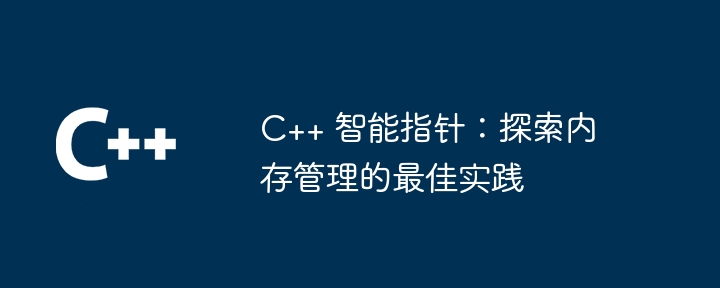c++++ 智能指针提供了对堆上分配对象的内存管理,包括独占所有权的 std::unique_ptr、共享所有权的 std::shared_ptr,以及用于跟踪对象存在的 std::weak_ptr。通过使用这些智能指针,可以自动释放内存并减少内存泄漏和悬空指针的风险,从而提高代码健壮性和效率。

C++ 智能指针:探索内存管理的最佳实践
简介
在 C++ 中有效管理内存对于编写健壮且高效的代码至关重要。智能指针是一种现代 C++ 技术,它旨在简化内存管理,避免常见的内存问题,例如内存泄漏和悬空指针。
智能指针类型
C++ 中有几种类型的智能指针,每一种都有自己的用途:
立即学习“C++免费学习笔记(深入)”;
使用智能指针
使用智能指针进行内存管理非常简单:
// 使用 std::unique_ptr std::unique_ptr<int> pInt = std::make_unique<int>(10); // 分配并初始化堆上对象 // 使用 std::shared_ptr std::shared_ptr<std::vector<int>> pVector = std::make_shared<std::vector<int>>(); // 分配并初始化堆上对象 // 当 pInt 超出范围时,它会自动释放内存
实战案例
考虑一个模拟学生数据库的简单程序:
#include <iostream>
#include <vector>
#include <memory>
using namespace std;
class Student {
public:
Student(const string& name, int age)
: name(name), age(age) {}
const string& getName() const { return name; }
int getAge() const { return age; }
private:
string name;
int age;
};
int main() {
// 使用 std::vector<std::unique_ptr<Student>> 将所有学生存储在 std::vector 中
vector<unique_ptr<Student>> students;
// 创建并添加学生
students.push_back(make_unique<Student>("John", 22));
students.push_back(make_unique<Student>("Mary", 20));
// 遍历并打印学生信息
for (auto& student : students) {
cout << student->getName() << ", " << student->getAge() << endl;
}
return 0;
}在这个示例中,我们使用 std::unique_ptr<Student> 来管理每个学生的内存。当 student 指针超出范围时,它会自动调用析构函数并释放堆上分配的内存。
结论
C++ 智能指针是内存管理的强大工具,可以帮助开发人员编写更健壮、更有效的代码。通过利用各种智能指针类型,您可以减少内存泄漏和悬空指针的风险,从而大大提高应用程序的可靠性。
以上就是C++ 智能指针:探索内存管理的最佳实践的详细内容,更多请关注php中文网其它相关文章!

c++怎么学习?c++怎么入门?c++在哪学?c++怎么学才快?不用担心,这里为大家提供了c++速学教程(入门到精通),有需要的小伙伴保存下载就能学习啦!

Copyright 2014-2025 https://www.php.cn/ All Rights Reserved | php.cn | 湘ICP备2023035733号